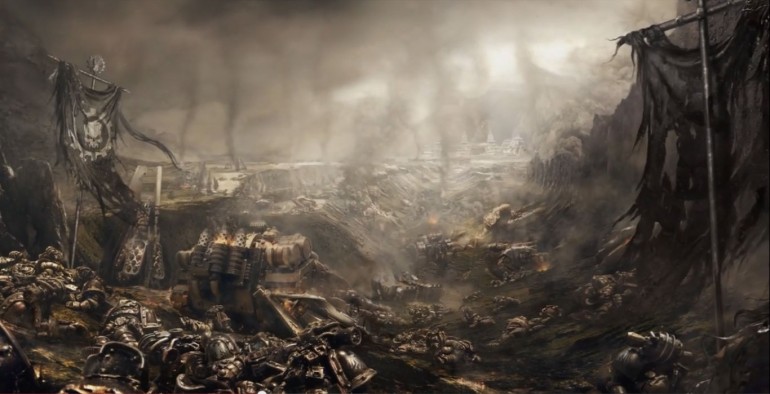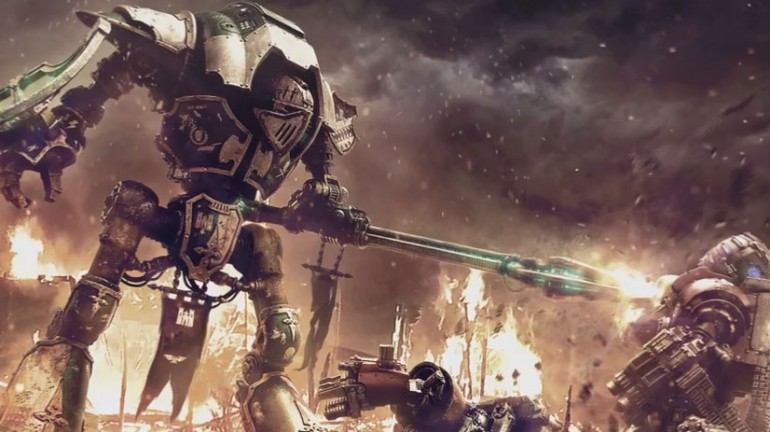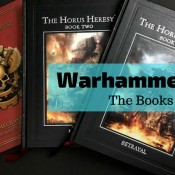Hello there, Knight of Infinite Resignation here, your friendly Remote-Scottish–Island-Dwelling-Kierkegaard-Aficionado.
We had a little conversation in the comments a week or two ago about starting to play Horus Heresy. Then I was reading the March White Dwarf and I noticed a completely inadequate two page spread on the same subject.
It struck me that for the interested non-player, 30K is extremely opaque and confusing. So many books and so many factions. Or is it so few? Hard to know where to start.
Well esteemed reader, be confused no longer. Like a fairly bright thing partially illuminating a slightly dingy corner, I am come to end your confusion, and perhaps encourage you to start playing this marvelous game.
You might have heard a lot of this before if you are vaguely interested, or even if you just hang out in 40k circles, but hopefully it will help someone to put it all down here. If not, well then my shallow storm-tossed life is without meaning.
Please forgive me if I patronize or repeat commonplaces, it is far from my intention.
A little caveat before we start. I am writing these articles on a heaving ferry in the middle of the North Sea in a Force 7 Gale. I don’t have my books here to look things up, so if I misremember something, please be merciful and point it out in the comments.
So Why Play 30K?
Well there are I’m sure as many reasons as there are players. Maybe more. Counting isn’t my strong point. Anyhow here are a few reasons you might have thought of, or not.
1) It still uses the rules for 7th edition Warhammer 40K
 Well this is more or less true, and may be a plus or a minus depending on how you feel about 8th. In reality, most of the rules for 7th are followed, but there are significant differences.
Well this is more or less true, and may be a plus or a minus depending on how you feel about 8th. In reality, most of the rules for 7th are followed, but there are significant differences.
Firstly, scoring is like in 5th, so with a couple of exceptions Troops are the only scoring units and other units are purely denial units. Just as it did in 5th, this makes Troops very important and you won’t win many games without a good number, helping armies feel a bit more realistic and reducing the spamming of uber-destructive units.
Army building is completely different, being based on 6th. With a couple of exceptions, armies are built from a CAD-like detachment, which allows 3 HQs, 4 Elites, 6 Troops, 3 Fast Attack and 3 Heavy Support plus a Fortification.
There are a couple of additional optional themed Force Org Charts if you and your opponent feel like some variety, but this is the basic one you are most likely to see.
Then you can add a single Allied Detachment (1HQ, 2 Troops, 1 FA, 1 Elite, 1HS). There are various levels of allies, Sworn Brothers, the closest level where unit joining is permissible, is fairly rare.
There are no Formations or their equivalents. Neither does filling out a FOC get you any bonuses or stratagems. However, there ARE ways to change up the army structure, called Rites of War, and we will come to them later.
To prevent MSU (multiple small units) builds most missions have a Kill Points element, and also most units are quite expensive for the first few guys, but adding more guys is very cheap, encouraging the fielding of big units and fewer of them. Thus, even at high points levels, the game goes quickly as there are not that many units running about.
Lastly on the army building front, Lords of War (which usually includes Primarchs) are restricted to a single slot and to no more than 25% of the total army points. Knights cannot be fielded singly, so no adding a Knight to your list to give it punch, you must commit to a Knight allied detachment of one HQ and one Troop if you want any Knights at all, meaning you WILL be short of scoring troops.
There are many other small balancing changes, perhaps the biggest being to the psychic phase. There is no Invisibility power and Summoning is very highly restricted to only Word Bearers Librarians, and maybe one or two other models. Daemons cannot summon more Daemons.
All this adds up to a very different feeling game with much more balanced armies.
2) There is far less rules churn
This is perhaps my favourite thing about HH. The books are released fairly slowly, one or two a year, and new units and factions are drip fed into the game.
This means that the ‘meta’ isn’t constantly changing, you do not need to continually buy new books, you do not need to continually change your army or replace wargear. Stuff that is good this year will not suddenly become rubbish next year.
Doesn’t that make it boring I hear you ask? Well no because…
3) There is a huge variety of ways to play
FW have provided us with several sets of missions, representing the battles around Istvaan, typical raid style missions that the shattered remnants of legions might fight post-Istvaan, City Fight missions and even a couple of full campaign systems to play with if you feel like invading an entire planet or sector.
If you get bored with normal games there is a skirmish Kill-Team/Necromunda type variant where small teams of troops compete for resources and gain experience. Or you could play Zone Mortalis, battles inside bunker complexes or set onboard Starships in the void.
Zone Mortalis is actually a great way to start playing since it typically features armies of between 500 and 1000 points, although you will need a fair amount of terrain. The fancy Zone Mortalis boards from FW are optional, just covering a 4×4 with loads of intricate line of sight blocking terrain, with doors in some of the gaps between terrain elements works just as well.
But isn’t it all Marines all the time?
4) There is a surprising number of playable factions that all feel very different
There are six non-Marine factions.
Firstly the Mechanicum (not Mechanicus). They have tough very customisable HQs, many types of Monstrous Creature robots, a variety of either elite multi wound infantry or horde style Troops (lobotomised undead tech thralls anyone?) plus extremely tough vehicles and can take Imperial Knights as part of their army.
Secondly there is the Imperial Knights themselves which can be an independent faction.
Then there are two other human armies- the Solar Auxilia who are extremely elite (for non-Astartes) with excellent equipment, stats and special rules, and the much more varied Imperial Militia and Chaos Cults.
The Militia and Cults army list is incredibly adaptable. You choose two ‘provenances’ for your army, varying from Tainted Flesh to Abhuman Helots or Survivors of the Dark Age, there is quite a list…
These provenances and the basic army list can be used to represent anything from non-Compliant civilisations which survived the Dark Age of Technology with their own versions of power armour, Rhinos and Land Raiders. It can represent Squats, an Imperial Governor’s Planetary Defence Force, the private armies of Rogue Traders or simply the ravening hordes of insane poorly equipped scum herded into battle by some of the Traitor Legions.
Then we have the Talons of the Emperor, ie Custodes and Sisters of Silence.
Lastly, Chaos Daemons can be taken as allies by Word Bearers under certain circumstances.
 Then we come to the Marines. All the Legions have at least basic rules. Dark Angels, White Scars and Blood Angels haven’t had their full rules yet, so no unique units or Primarchs for them, but they will be on the way soon.
Then we come to the Marines. All the Legions have at least basic rules. Dark Angels, White Scars and Blood Angels haven’t had their full rules yet, so no unique units or Primarchs for them, but they will be on the way soon.
All the Marine armies follow the same format and are built from the same army list with the addition of two or three special units and characters per legion.
Each Legion also has a few special rules of its own to add flavour and character. You might think this would lead to identikit lists, but the saving grace here is the Rite of War system. Certain HQs unlock Rites of War. Each Legion will likely have two or three of its own unique Rites of War, there are a whole bunch of generic ones that almost every Legion can use and some unique to Traitor or Loyalist aligned forces.
Taking a Rite of War (and you can only take one) can change your force in a great variety of ways, some give additional extra bonuses (and penalties), some change army construction, giving more slots or moving units from one slot to another.
Some give special rules to particular units (such as Deep Strike to Terminators) or to the whole army. For example, Iron Hands have a Rite of War that allows all their tanks to outflank, some allow you to take a Primarch outside of a Lord of War slot.
Adding a bit more variety again are the rules for Blackshields (mystery Astartes who have no iconography and follow their own agenda, either Loyalist, Traitor or maybe just space pirates or deserters), and Shattered Legions – armies constructed from multiple Legions representing cobbled together task forces or scattered survivors banding together.
5) The models are stunning
 They are generally in a more realistic and less cartoony vein than Games Workshop’s core ranges, as is fitting a more gritty and realistic setting.
They are generally in a more realistic and less cartoony vein than Games Workshop’s core ranges, as is fitting a more gritty and realistic setting.
6) The fluff is EPIC!!!!
It’s the f*cking Heresy!
Play the characters and the forces in the battles from the books that you love.
7) The unloved is loved…
You want convincing and different feeling rules for that ignored Space Marine faction, you got it! Although there are differences in power levels between forces, FW do a pretty good job balancing and the players also take this seriously. The 30k community is more keen to make the game work than to break it. Which brings us to…
8) The culture of Horus Heresy/30K players
HH players are a different breed to 40K players. Perhaps the expense (though that can be mitigated), the perceived exclusiveness or the seriousness of this ‘historical’ game or the simple fact that there are fewer players more thinly spread changes how they interact with each other.
WAAC players are extremely rare, and so is min-maxing and over competitiveness of the sort common in 40K. Lists are often shared on Facebook groups not to make them more powerful, but to ask if they are too powerful or too cheesy and whether they should be toned down! Quite a different attitude.
People seem more attached to their armies and the much lower amount of ‘churn’ and meta change facilitates people building beautiful and extensive collections. HH players are a friendly, respectful and helpful bunch. They even smell nicer than 40k players. OK I made that last bit up…
So if I have whetted your appetite stay tuned for the next instalment when I will discuss HOW to go about starting HH and the books you will need. After that one will be ways to save money and talking power armor marks.
- Saving Money with Warhammer 30K + Power Armor Marks - May 11, 2018
- Warhammer 30K (Horus Heresy) Rulebooks You Need to Play the Game - May 7, 2018
- 8 Reasons to Play Horus Heresy (Warhammer 30K) - May 2, 2018






Great article. Really spells out the difference how 30k is different from what is both perceived and generic 7th ed 40K.
I’d maybe also note that 30k games are significantly faster then 40K 8th ed.
thats a good point, its amazing how fast a 2500 or 3000 point Heresy game will go in comparison to the equivalent 40k game, either in 7th or 8th.
Nice write-up and certainly enticing reasons.
I’m looking forward to seeing the rest of these go up.
HH is something I’ve thought long and hard about. I’ve had a couple of reasons to dismiss it; no one plays it around my neck of the woods and my Slaanesh Marines aren’t Emperor’s Children.
Although you raise many enticing points, reason number 8 is what piques my interest the most though. 40k has devolved into a WAACers wet dream, people are now paying people to design army lists for them….WTF?
It’ll be interesting to see your next instalment, as I’ve always wanted an excuse to paint the Night Lords models….although the Word Bearers models are not without their charm ;-)
I’ve found it just takes one or two people to start playing, and then you discover that there are lots of people interested, but no-one has ‘made the jump’ because they were all worried no-one else would play :-)
Zone Mortalis is an easy place to start. At 1000 points its possible to collect two sides, either two Legions you like or a Legion and what will become their allied contingent for a bigger army. A 3×3 board and enough terrain to fill it should be reasonably achievable too. Then you can do demo games. Thats how we started at my club, within a few weeks we had a bunch of guys with ZM armies.
You may even find you have enough models already for 30k, I’ll come to that in a later installment- building 30k armies from 40k minis…